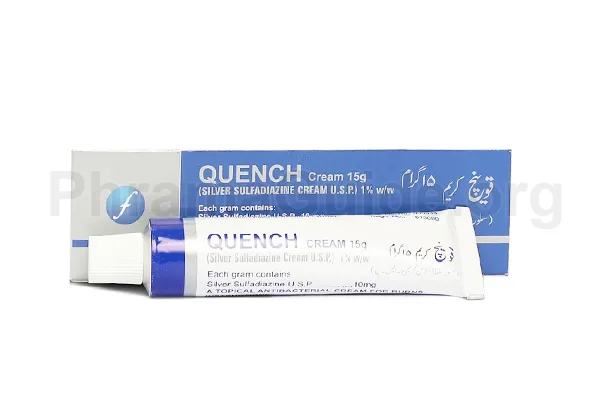Quench cream is a topical medication, that is primarily used for treating burns and preventing infection in burn wounds. Quech cream, a stalwart in wound care and burn treatment holds a special place in the realm of medical skincare. Its diverse applications and efficacy in promoting healing have made it a vital tool for healthcare providers.

Common Uses and Indications of Quench Cream
- Burn Wounds: One of the most common uses of Quench cream is for the treatment of burn wounds. It helps prevent infection in burn injuries by killing or inhibiting the growth of a wide range of bacteria that could potentially colonize the damaged skin. The cream is applied directly to the burn area after proper wound cleaning and debridement.
- Skin Grafts: After a skin graft procedure, where healthy skin is transplanted to replace damaged skin, Quench cream may be applied to the graft site to prevent infection and promote healing.
- Skin Ulcers: Quench cream can also be used for the treatment of certain types of skin ulcers, such as those caused by pressure injuries (bedsores) or vascular insufficiency. The antimicrobial properties of the cream help reduce the risk of infection in these open wounds.
- Other Wound Types: In addition to burns and ulcers, Quench cream might be used for the prevention or treatment of infections in other types of wounds, such as traumatic injuries or surgical wounds, where the risk of infection is a concern.
- Partial-Thickness Wounds: Quench cream is particularly effective for treating partial-thickness burns, where the outer layer of skin (epidermis) and a portion of the underlying layer (dermis) are affected. The cream can help reduce pain, prevent infection, and support the healing process.
Off-label Uses of Quench Cream
- Chronic Ulcers: Quench cream may be used off-label to treat certain types of chronic skin ulcers, such as venous stasis ulcers and diabetic foot ulcers, to help prevent and manage infection and promote wound healing.
- Skin Graft Donor Sites: While the cream is commonly used on graft recipient sites, it might also be used off-label on the donor site where the healthy skin is harvested. This can help prevent infection and promote healing in the donor area.
- Partial-Thickness Wounds: Apart from burn wounds, Quench cream might be considered for treating partial-thickness wounds caused by trauma or surgical procedures.
- Skin Tears and Abrasions: Quench cream could potentially be used for preventing infection and supporting healing in cases of minor skin tears, abrasions, or cuts.
- Topical Antimicrobial: In certain situations where infection risk is high and systemic antibiotics are not appropriate, Quench cream might be considered as a topical antimicrobial agent.
- Bacterial Colonization Prevention: The antimicrobial properties of Quench might be utilized to prevent bacterial colonization in various types of wounds that are susceptible to infection.
- Catheter Exit Sites: Quench cream might be used off-label to prevent infection at catheter exit sites, although other specialized products are often preferred for this purpose.
- Skin Infections: In rare cases, Quench cream might be used off-label to manage localized bacterial or fungal skin infections, although other treatments are typically preferred.
Formulation and Key Ingredients
- Silver Sulfadiazine: 1%w/w
Quench cream’s efficacy is attributed to its formulation, which combines silver ions and sulfadiazine. Silver ions have antimicrobial properties that help control bacterial growth, while sulfadiazine aids in preventing infections and promoting healing.
Applying Quench Cream: Techniques for Optimal Healing
Proper application is crucial for maximizing the benefits of Quench cream:
Cleanse: Thoroughly clean the burn or wound area before applying the cream.
Thin Layer: Apply a thin layer of the cream directly onto the affected area.
Cover or Dress: Depending on the wound’s severity, cover it with a sterile dressing or leave it exposed as advised by a healthcare professional.
Who Should Exercise Caution with Quench Cream?
While Quench cream is highly effective, certain individuals should be cautious:
Those with known allergies to sulfonamide medications or silver.
Pregnant or breastfeeding individuals should consult a doctor before using the cream.
Individuals with certain blood disorders or enzyme deficiencies.
Frequently Asked Questions (FAQs)
- Q: Can Quench cream be used on minor cuts and scrapes?
While it’s not the primary purpose, some healthcare providers might recommend it for such cases. - Q: Does Quench cream speed up wound healing?
It primarily prevents infections, which in turn can support the healing process. - Q: Is this cream available over the counter?
No, Quench cream usually requires a prescription. - Q: Can Quench cream be applied to the face?
It’s generally not recommended for facial use due to potential side effects. - Q: Can I use Quench cream on my child’s wound?
Pediatric use should be discussed with a healthcare professional.
Quench Cream’s Alternatives : Other Similar Brands
The following are Some alternative brands of Quench Cream and their manufacturers.
- Bio Sul : Bio Labs (Pvt) Ltd, Pakistan.
- Burnasil : Bloom Pharmaceuticals (Pvt) Ltd, Pakistan.
- Burnazine : Wilsons Pharmaceuticals, Pakistan.
- Dermazin : Novartis Pharma (Pakistan) Ltd.
- Dermaflam : Mediceena Pharma (Pvt) Ltd, Pakistan.
- Flamoff : Valor Pharmaceuticals, Pakistan.
- Mazine : Global Pharmaceuticals, Pakistan.
- Silvate : GalaxoSmmithKline (GSK).
- Silvin : P.D.H. Pharmaceuticals (Pvt) Ltd, Pakistan.
- Silvench : Ambrosia Pharmaceuticals, Pakistan.

Leave A Comment